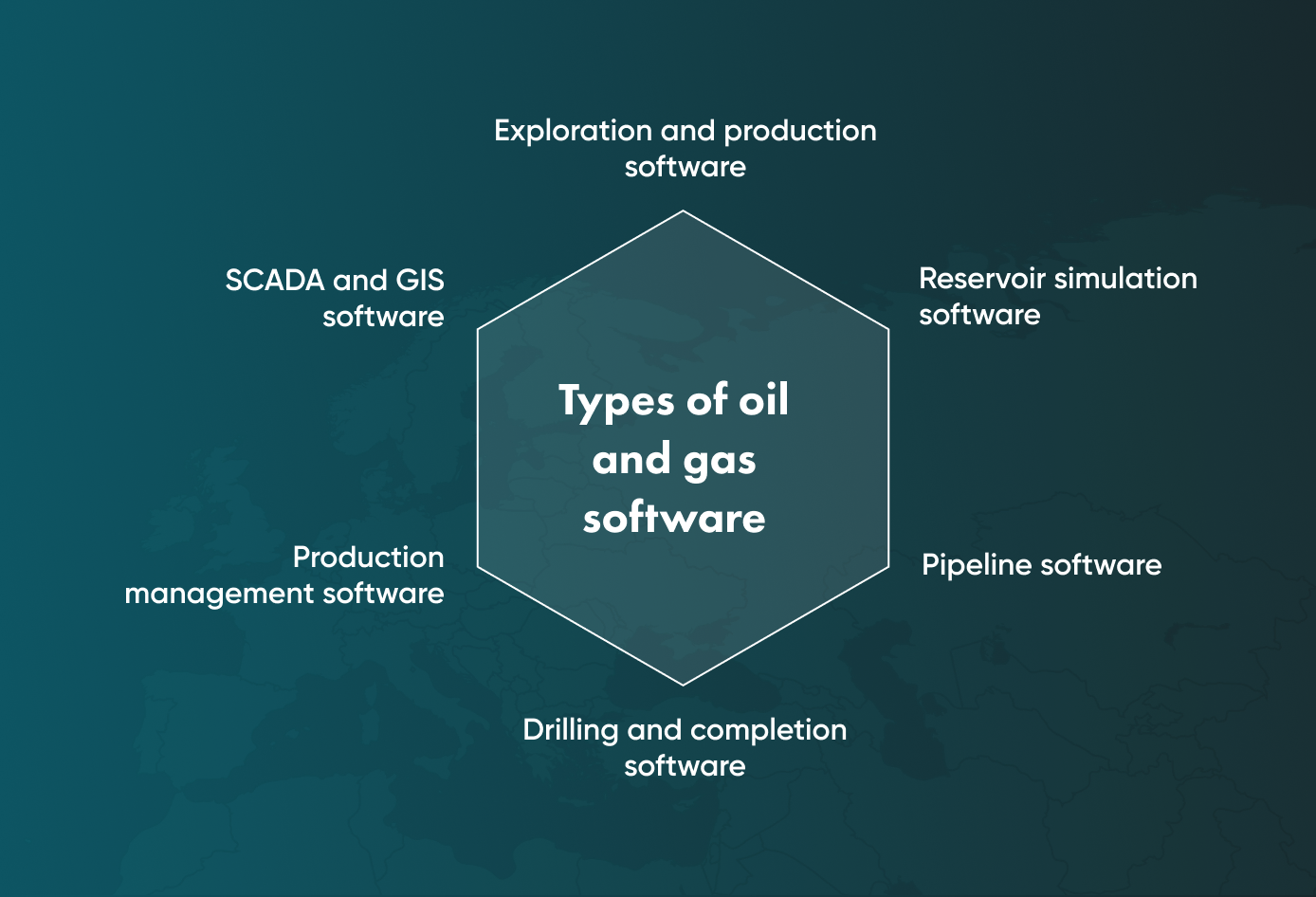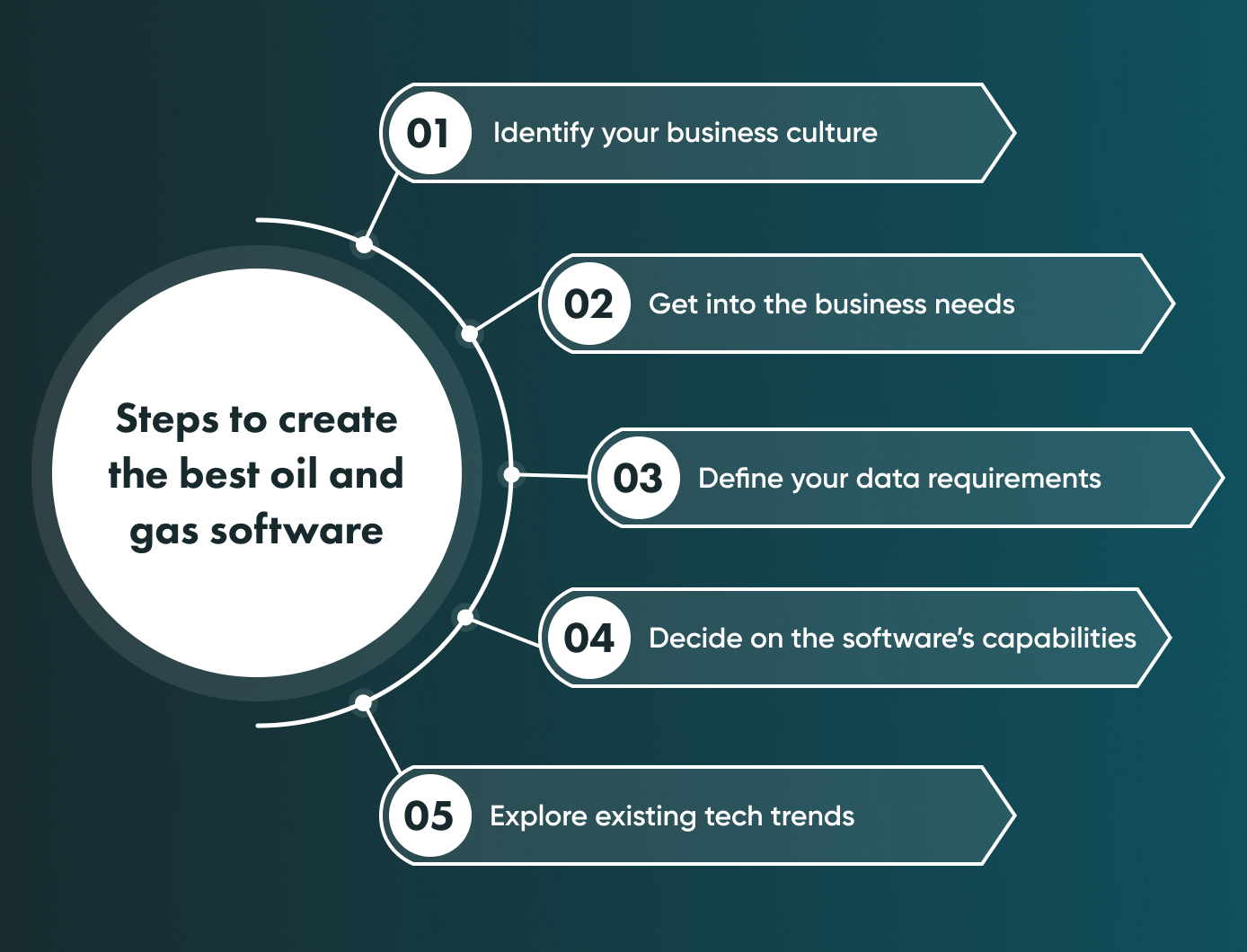Oil and Gas Software: Its Types, Its Applications, and Everything Else You Need to Know


Today, it’s hard to imagine doing business efficiently without using different types of software tools. This is because most verticals have digitised and completely transformed their business processes.
Take oil and gas companies, which rely on various software tools to help them manage their resources, optimise their operations, and stay competitive in a rapidly changing marketplace, for example.
Whether you're an industry professional looking to stay up-to-date on the latest technology trends or a newcomer interested in learning more about the software that powers this vital sector, this article is for you.
Below, we will share everything you need to know about the most commonly used types of software for oil and gas engineering and the roles they fulfil.
This includes oil and gas software for exploration and production, reservoir modelling, drilling and production management, and much more.
Let's dive in and explore the oil and gas software world!
Types of oil and gas software

There are different web and mobile applications aimed to enhance daily tasks in the oil and gas industry. Let’s check them out.
Exploration and production software
Exploration and production software manages and interprets geological and geophysical data, plans exploration activities, and optimises production.
This type of software helps companies identify potential oil and gas reserves, analyse data, and make informed decisions about exploration and production activities.
Examples of popular exploration and production software include Schlumberger's Petrel and Halliburton's Landmark suite.
You will find all the details of software examples in the next section.
Reservoir simulation software
Reservoir simulation software is used to predict the behaviour of oil and gas reservoirs, simulate reservoir conditions, and optimise production.
This type of software is essential for reservoir management, as it allows companies to model reservoir behaviour and evaluate production strategies. Famous reservoir simulation software examples include Schlumberger's Eclipse and CMG's IMEX.
Drilling and completion software
Drilling and completion software plans, monitors, and optimises drilling and completion operations. This software helps companies reduce drilling time, minimise risks, and improve wellbore quality.
Examples of drilling and completion software include Baker Hughes' JewelSuite and Halliburton's WellPlan.
Production management software
Production management software monitors and manages production operations, optimises production processes, and analyses production data.
Due to production management software, companies improve production efficiency, reduce costs, and increase profitability.
Examples of oil and gas production software include Honeywell's UniSim.
Pipeline software
Pipeline software in oil and gas refers to computer programs used to manage and monitor the flow of oil and gas through pipelines.
These software applications are designed to optimise pipeline performance, enhance safety, and minimise environmental impact.
Pipeline software can include features such as leak detection, corrosion monitoring, pressure control, and real-time data analysis.
SCADA and GIS software
SCADA (supervisory control and data acquisition) and GIS (geographic information system) software aim to monitor and control processes, display data, and analyse geographic information.
Examples of SCADA software include GE's iFIX and Siemens' WinCC, while examples of GIS software include Esri's ArcGIS and Bentley's MicroStation.
SCADA systems are used not only for oil and gas processes but can also be applied in many industries.
In our detailed article, you can find more information about SCADA, its importance, and how to secure one.
Are you planning to create oil and gas software for your company’s purposes? Then contact Go Wombat, and we will help you create the right development plan.
Examples of oil and gas software and how they work
Now, we can proceed to the examples of O&G software we provided above and look at their characteristics.
It’s important to note that all of the off-the-shelf solutions we will name in this section have the same limitation: they can not be fully customised to your enterprise’s unique requirements.
In the vast majority of cases, having a custom oil and gas software solution designed specifically for your operation produces the best results. If you want to know more about getting a custom solution built by oil and gas software experts, contact Go Wombat today.
With the above in mind, here are some of the most popular types of O&G software.
Software for exploration and production
Petrel is a powerful software tool for seismic interpretation, well log analysis, and reservoir modelling. It helps geologists and geophysicists visualise subsurface geology and evaluate potential oil and gas reservoirs.
The software can also be used to plan and optimise production operations, allowing companies to maximise their recovery from oil and gas fields.
Halliburton's Landmark suite is another popular software package applied in the oil and gas industry.
The suite includes various software tools for reservoir characterisation, drilling and completion, and production operations.
For example, Landmark's DecisionSpace software is used for reservoir modelling and simulation, while its Drilling and Completions software helps companies to plan, monitor, and optimise drilling and completion operations.
Software for reservoir simulation
Eclipse is a widely-used reservoir simulation software package that is used for predicting fluid flow and transport in hydrocarbon reservoirs.
In addition, the software can be used to simulate reservoir performance under a range of production scenarios, enabling companies to optimise their production strategies.
CMG's IMEX (Implicit Multiphysics EXplorer) software is a comprehensive simulation tool designed for modelling a wide range of multiphase fluid flow scenarios.
It is used by engineers and researchers across industries, including oil and gas, chemical processing, and environmental engineering. It’s also leveraged to improve their operations and processes.
IMEX's advanced numerical algorithms allow it to simulate complex multiphase flow phenomena, including fluid dynamics, heat transfer, mass transfer, and chemical reactions.
Software for drilling and completion
JewelSuite is a comprehensive software suite used for wellbore modelling, drilling optimisation, and geomechanics analysis. The software helps companies modify and improve drilling operations and wellbore stability.
WellPlan is another widespread drilling and completion software package created for planning and designing drilling operations.
The software includes various tools for wellbore design, casing design, and cementing operations.
Moreover, the WellPlan software integrates multiple data sources, including geological, geophysical, and drilling data, to generate realistic 3D models of the subsurface formations, enabling drilling engineers to make informed decisions about well design and drilling operations.
Software for production management
UniSim is a comprehensive software package used for process simulation and oil and gas modelling. The software helps companies to enhance production processes, reduce downtime, and improve product quality.
It can model a wide range of unit operations, including distillation, heat exchangers, reactors, compressors, pumps, and pipelines.
One of the key features of UniSim is its high-fidelity simulation capability, which enables users to accurately model process systems under a range of operating conditions.
As a result, this oil and gas data management software allows engineers to optimise process designs and operations, reduce costs, and increase efficiency.
Pipeline software
In this section, we’ll cover 3 distinct solutions: the AVEVA Pipeline Manager, Schneider Electric Pipeline Operation, and Honeywell Enraf Pipeline Manager.
AVEVA Pipeline Manager
This software provides comprehensive management of pipeline design, operation, and maintenance. It enables engineers to design pipeline routes, perform hydraulic simulations, and monitor pipeline performance in real-time.
Schneider Electric Pipeline Operation
This software provides a complete view of pipeline operations, including real-time data, alarms, and events. It also enables operators to manage pipeline flows, detect leaks, and prevent overpressure situations.
Honeywell Enraf Pipeline Manager
This software provides accurate and reliable data for pipeline management, including custody transfer, leak detection, and batch tracking. It also enables operators to optimise pipeline performance by identifying and addressing bottlenecks and other issues.
SCADA and GIS software examples
GE's iFIX software is a powerful SCADA software used for real-time monitoring, control, and data acquisition in various industries such as oil and gas, water and wastewater, and power generation.
It is designed to provide a comprehensive view of industrial processes, allowing users to make informed decisions in real-time.
iFIX can collect real-time data from various industrial devices and sensors, such as PLCs (programmable logic controllers), DCS (distributed control systems), and RTUs (remote terminal units).
Besides that, iFIX offers an intuitive drag-and-drop interface that allows users to create a custom HMI (human-machine interface) to monitor and control their processes.
The HMI can include various elements such as alarms, trends, and data displays.
Elements to consider before creating custom software for your oil and gas company

Once you decide where to use oil and gas integrated systems in your business, you must research the most relevant solutions.
If you want the software to meet all your needs, you need to create it from scratch.
Existing apps are considered functional, but will not meet all of your business requirements – especially if you’re looking to only employ one application.
That is why you need to build oil and gas industry software designed for your company.
Here are the steps to create a custom application for oil and gas.
Identify your business culture
The choice of software depends on how your business works at a people and operational level.
Therefore, you must understand the essence of your company culture, foresee how your organisation will react or adopt the new technology, and consider certain factors in the planning phase.
You should consider the current size of your business, clearly determine future plans, understand the complexities of your business, and be aware of all potential risks to your business.
When introducing changes to your business, such as new technology or processes, it is crucial that you convey the value of these changes to your employees.
This will make them more willing to change the business and can help improve your organisation's culture. If people understand the business value of software, they are more likely to accept change, be trained on new systems and processes, and use those systems more effectively.
Get into the business needs
Several factors, including internal company shifts and external market fluctuations, may have influenced your organisation's need for a technology change.
Thus, before deciding to move forward with a plan, you must identify what is driving those decisions by conducting a “current state” business process analysis where you can quickly identify pain areas.
Software selection is a complicated decision. The right software can be a valuable asset to any business. However, there is no one-size-fits-all solution, remember?
Companies must consider the specific needs of their organisation when deciding which software to suit their needs.
Define your data requirements
It’s important to determine the data needs of the end-users in your oil and gas company. Here are some factors to consider when choosing data needs:
Type of data
The data type required for oil and gas software can vary depending on the application. For example, drilling and exploration software may require geological data such as seismic surveys, well logs, and core samples. Production software may require data such as flow rates, pressures, and temperatures.
Data sources
Identifying the origins of the required data is critical. Data sources include internal sources such as sensors and databases and external sources such as third-party data providers.
Data quality
The quality of data is vital for accurate analysis and decision-making. Data quality can be affected by factors such as errors in measurement, data entry errors, and data processing errors.
Data storage
The storage and management of data are essential for the efficient and effective use of the software. It includes determining the appropriate storage technology, data retention policies, and data security.
Data analysis
Data analysis is critical to oil and gas software, enabling users to make informed decisions. This factor implies identifying the types of analysis required, such as trend analysis, predictive modelling, and anomaly detection.
Decide on the software’s capabilities
When creating oil and gas management software, consider the capabilities that the software has to offer. The software's capabilities should be tailored to the specific needs of the oil and gas industry and should provide the necessary tools to increase efficiency and productivity.
Discuss the following issues with a development company like Go Wombat: the user interface, the ease of use, and the ability to integrate with other systems. As well, be sure to look at the available customer support and training options.
By taking the time to consider the capabilities of the oil and gas software, you can make certain that you are selecting the best software for your needs. In addition, it will ensure that the software can provide the necessary tools and features to increase efficiency and productivity.
Explore existing tech trends
One of the most significant advantages of exploring tech trends is that it can help improve oil and gas software performance.
By staying on top of the latest trends, your team of developers can see to it that your software is as efficient and effective as possible.
This will contribute to reducing costs and increasing productivity, both of which are crucial for the success of any oil and gas business.
Take a moment to read our article about digital transformation and top technological trends in the oil and gas industry. Also, we have a comprehensive article about artificial intelligence use in the oil and gas business that you may also find interesting.
Exploring tech trends can also help ensure the software is secure.
As technology advances, so do the threats posed by hackers and other malicious actors. By staying up-to-date on the latest trends, entrepreneurs can verify that their software is secure and can protect their customers' data.
Conclusion
In conclusion, exploring tech trends is essential to creating oil and gas software. By staying up-to-date on the latest developments, developers can ensure their software is as efficient and secure as possible, helping create a path for the success of any oil and gas business.
The oil and gas industry may require entirely different software types. Among them, you could see examples of oil and gas project management software, drilling and completion software, and pipeline software.
So, you will need to build an app that meets your niche’s needs. And Go Wombat will provide assistance in any area of your project that needs additional support – or completely build your solution from scratch.
Don’t hesitate to contact us any time. We will take care of the rest!
Unlock Success with Premium Software Development
Contact us


FAQ
What is gas and oil software?
Gas and oil software refers to a type of software specifically designed for companies in the oil and gas industry. It manages and optimises operations and tracks oil and gas resource exploration, production, and distribution data, among other essential tasks.
What does oil and gas software do?
Gas and oil software can help companies to improve efficiency, reduce costs, and make more informed decisions based on real-time data. Therefore, it is an excellent tool for companies in this industry to stay competitive and ensure the smooth functioning of their operations.
What is new software technology in oil and gas?
Several new software technologies are being developed and used in the oil and gas industry. Here are some examples:
- Artificial intelligence and machine learning: AI and machine learning algorithms analyse large amounts of data collected during exploration, production, and distribution processes.
- Internet of Things (IoT): IoT devices can collect real-time data from sensors and equipment, providing operators with valuable insights into the performance and condition of assets.
- Blockchain technology: Blockchain technology improves supply chain management and traceability in the oil and gas industry. This technology can help ensure compliance with regulations, reduce fraud risk, and increase supply chain transparency.
How can we help you ?








